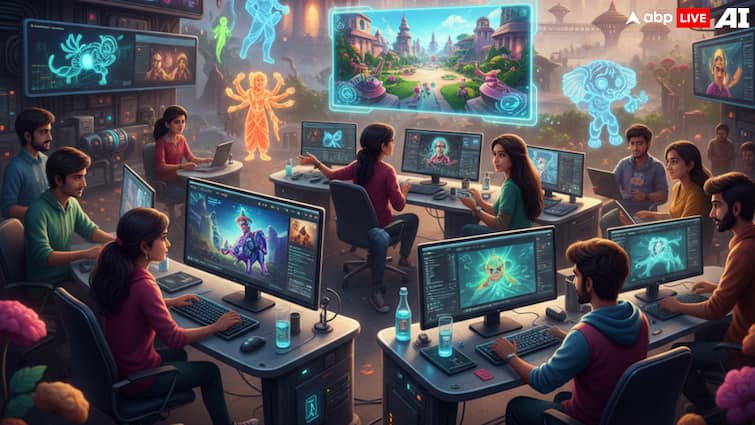By Manvendra Shukul
India’s creative economy, also known as the orange economy, is at a pivotal moment. Valued at over $30 billion and employing nearly 8% of the national workforce (Creative Economy Outlook 2024, UNCTAD), its potential for development is vast and waiting to be unlocked. Among its fastest-growing segments is Video Games, a sector that has not only captured the imagination of Indians but is also becoming a powerful economic engine for the country.
Globally, Video Games have already surpassed the combined revenues of the film and music industries. In India, it now accounts for 29.6% of the $12.5 billion New Media economy, outpacing OTT, audio, social media, and other sectors, according to the India Gaming Report 2025. But beyond these numbers lies a deeper opportunity – an often-underestimated force: the powerful trio of Game Art, Animation, and VFX. From captivating environments to lifelike characters and vivid storytelling, game art defines how players experience video games – and Indian Game Artists have long played an imperative role in shaping this experience for players worldwide.
A Strong Foundation
For years, Indian artists have played a key role in bringing to life some of the most iconic AAA, mobile, and indie video game titles worldwide. From concept design to final in-game assets, Indian studios have contributed across the full art production pipeline – building India’s reputation as a trusted partner globally. This strong foundation has laid the groundwork for the next leap – a launchpad for global creative leadership.
Cultural Shifts and Market Demand
Increasingly, young Indians are choosing to become creators. In 2023, there were more than 100 million content creators in India. As the “Content Capital of the World,” India now offers the space for a career in the visual arts medium of game art, animation, and VFX – once seen as unconventional – to gain appeal and be recognised as lucrative and legitimate.
This cultural momentum aligns with surging demand. India boasts one of the world’s largest mobile gaming audiences. According to Niko Partners 2025 Market Model Reports, India had 475.2 million gamers in 2024, a number expected to climb to 521.2 million in 2025 and nearly 724 million by 2029, growing at a five-year CAGR of 8.8%. This is likely to increase the demand for local artists who understand regional cultures and aesthetics, as global studios develop video games catering to Indian players, resulting in Indian talent becoming more relevant than ever on the world stage.
Focus on 3 Areas
India’s momentum is real, but becoming a global leader in game art requires focused effort in three key areas:
Policy Support to Expand Creative Exports
As global demand for digital art continues to rise, Indian artists have a major opportunity to lead in the interactive content space. Government support can be a game-changer in this regard. South Korea provides a powerful example. The creation of a dedicated “Hallyu” (K-Wave) department helped turn K-pop and K-dramas into global cultural exports.
India can take a similar approach to video gaming and digital art. Targeted interventions – such as incentivising indigenous game development and IP creation, supporting export-ready content, introducing industry-friendly policies to attract global studios to set up development bases in India, promoting Indian talent on international platforms, and enabling cross-sectoral collaboration across video games, film, and the Arts – can democratise access and accelerate growth in the industry.
Stronger Industry-Academia Collaboration
Prepare students for real-world jobs, education in game art, animation, and VFX must be closely aligned with current production needs. Curriculum should emphasise hands-on skills such as 3D modelling, digital sculpting, texturing, lighting, and engine workflows like Unreal and Unity.
Beyond classroom instruction, students need opportunities to gain exposure through internships, studio visits, and live projects. Local developer meet-ups and peer-led events can further strengthen learning ecosystems and foster industry engagement.
A Robust Mentorship Ecosystem
By expanding access to education in game art, animation, and VFX – especially in Tier 2 and Tier 3 cities – India can tap into a vast reservoir of untapped creative talent. Building a strong mentorship ecosystem is a critical enabler of creative growth in this regard. Providing emerging artists with direct access to industry experts – through both online platforms and in-person game-dev events – can accelerate learning, improve quality, and build creative confidence.
Looking Ahead
India’s creative economy is already thriving, and its next great frontier lies in the visual medium of video games. With a youthful tech-savvy population, a massive mobile user base, and a maturing ecosystem of game art talent, India is ready to help shape the future of global gaming.
In an age where creativity is the new currency, India’s strength in Animation, Game Art, and VFX, can play a key role in positioning India as one to watch in the global orange economy. This trio art is our gateway. Let us invest in them. Let us lead with them.
(The author is the Founder and CEO, Lakshya Digital)
Disclaimer: The opinions, beliefs, and views expressed by the various authors and forum participants on this website are personal and do not reflect the opinions, beliefs, and views of ABP Network Pvt. Ltd.



